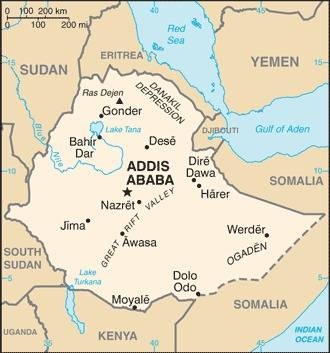
Customs and Cuisine of Ethiopia
Fast Facts
– Location: Ethiopia is a landlocked country in the Horn of Africa. It shares a border with Sudan, South Sudan, Somalia, Eritrea, Kenya, and Djibouti.
– Name Origins: The name “Ethiopia” is supposed to be derived from Greek terms meaning “of burnt visage.” Historically, the land containing present-day Ethiopia and Eritrea was known as the Kingdom of Abyssinia.
– Population: As of 2022, the estimated population of Ethiopia is 113 million. It ranks among the top ten fastest-growing populations in the world. Ethiopia boasts a very diverse population, with over 80 languages spoken, and as many ethnic groups calling the country home. The largest ethnic groups are the Oromo, Amhara, Tigrayans, and Somali.
– Religion: Ethiopia has a long history of ties to Christianity and Islam. In 2016, approximately 44 percent of residents identified as Ethiopian Orthodox Christians, while just under one third were Muslim. The rest are a mix of traditional local faiths and other Christian denominations.
– Language: The most common languages spoken in Ethiopia are Oromo and Amharic, although throughout the country there are over 80 languages spoken.
Claim to Fame/Infamy
Battle of Adwa
Ethiopia is the only African country that has never been colonized. At the Battle of Adwa on March 2, 1896, Ethiopians defeated Italian forces bent on colonizing their land and claiming it as their own. The Ethiopian victory was felt around the world during a time when many peoples were losing their native lands to European colonialism. The anniversary of the battle is still celebrated as a symbol of African freedom and Ethiopian national pride.
Ten years before the battle, European leaders met at the Berlin Conference to divide Africa –with no input from Africans themselves – into colonial territories. It was decided at the conference that Ethiopia would go to Italy. After a period of horrible famine and disease that wiped out an entire third of Ethiopia’s population, Italy began moving in and attempting to stake their claim.
Emperor Menelik II rallied the Ethiopian forces and called on all citizens able to fight to join them. One hundred thousand Ethiopians from all walks of life, both men and women from a wide variety of ethnic and tribal groups, answered his call. They were poorly armed or unarmed, but they far outnumbered the invading Italians, and claimed victory in the Battle of Adwa.
The People of Ethiopia
Ethiopia is a highly diverse nation, so it is difficult to generalize about the traditions, language, and way of life for all Ethiopian people. Ethiopians hail from locations as diverse as urban metropolitan areas like Addis Ababa to the grasslands of the Omo River Valley, where the Mursi and Bodi tribes have lived for centuries.
There are over 80 languages spoken throughout Ethiopia, with the majority of people speaking either Amharic or Oromo. Amharic is the official working language of the Ethiopian government, but all languages are recognized as official state languages. Christianity is the most predominant religion, with over half of Ethiopians identifying with a Christian denomination. The next most popular religion is Islam, which is the religious affiliation of around one third of citizens. Each of these groups has their own distinct set of cultural practices.
Ethiopian Cuisine
Ethiopian cuisine is as diverse as the Ethiopian people. Common ingredients throughout the country include vegetables, flatbread, and spicy meats. The national dish is Doro Wat, which is a red pepper chicken stew with eggs that is often served over injera, a type of sourdough flatbread made from teff, one of the world’s super grains.
Those Ethiopians adhering to Orthodox Christianity or Islam avoid eating pork or shellfish, as it is considered to be unclean. Much of the common Ethiopian diet is largely vegetarian as a result. Food is typically eaten with hands and shared at table with friends and family. An example of a meal might be injera served with a variety of vegetables, legumes, and possibly meat.
Berberé is a spice that is commonly used to add flavor to other dishes, and is a mix of chili pepper and cardamom, fenugreek, cloves, ginger, and other spices. Another common ingredient is niter kibbeh, a type of butter infused with garlic and ginger.
The Ethiopian Way of Life
While the specific customs vary by region in Ethiopia’s diverse citizenry, coffee is an important element of many people’s everyday lives, and serving coffee is an important ritual at social gatherings. Being invited to a family’s coffee ceremony is a sign of respect and friendship.
The coffee ceremony is a lengthy process that constitutes processing raw coffee beans into cups of coffee. The raw beans are washed and roasted, then ground with a mukecha and zenezena (similar to a mortar and pestle). Water is brought to boiling and the ground beans are added, then the resulting coffee poured into coffee cups. Coffee is shared with visitors, friends, and relatives, and is typically made by women in the household.
As most of Ethiopia’s population lives in rural areas, there is a strong emphasis on agriculture in their economy and daily lives. Most people in the country make their living by subsistence farming. Common crops include coffee, beans, potatoes, and sugarcane. Women typically manage the home, taking care of children and food preparation, while men typically focus on agricultural activities. Children often work from a young age to help support their family, and the labor is arduous, sometimes dangerously so. For example, girls are oftentimes tasked with carrying huge amounts of water on their backs daily.
View Recipes from Ethiopia
Ethiopia
